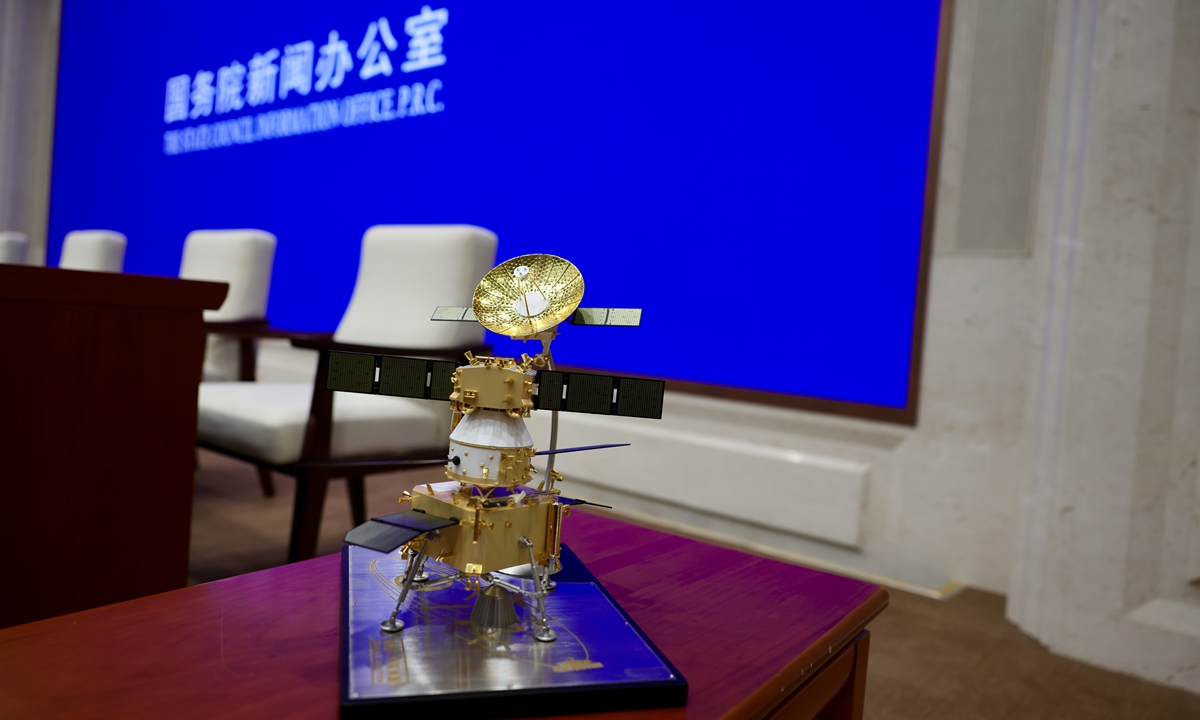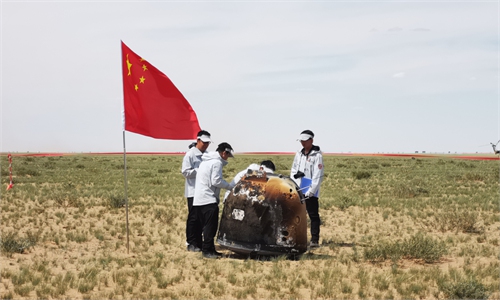China to unveil weight of first-ever far side lunar samples
Chang'e-6 mission a journey of exploration, innovation, intl cooperation: CNSA deputy head

A miniature of the Chang'e-6 probe is on display at a mission special briefing held in the State Council Information Office on June 27, 2024. Photo: Deng Xiaoci/GT
China will unveil the weight of the first lunar samples taken from the far side of the moon by the country's Chang'e-6 robotic probe mission on Friday, according to mission chief designer Hu Hao on Thursday.
Hu made the remarks at a special media briefing held by the State Council Information Office on Thursday in Beijing.
Hu revealed that the Chang'e-6 mission aims to return 2 kilograms of lunar samples from the far side of the moon, which is same weight as the samples collected during the Chang'e-5 mission on the near side of the moon. According to the chief designer, the sampling work of the Chang'e-6 went even more smoothly than its predecessor.
Hu asked the public to wait patiently for another day and there will be more surprises coming in the latest mission.
Bian Zhigang, deputy head of the China National Space Administration (CNSA), told media at the event that the Chang'e-6 mission is a journey of exploration, of innovation and of international cooperation.
"Chang'e-6 chose to land on the edge of the Apollo crater in the northeast of the South Pole-Aitken basin, which is the oldest, largest and deepest known crater on the moon. By analyzing the lunar samples collected from this site, scientists are expected to uncover more scientific mysteries such as the evolution of the solar system and moon," the CNSA deputy administrator said.
Also, the Chang'e-6 mission is the most technologically advanced lunar exploration mission in China's space history so far. It has achieved three technological breakthroughs and one world first. Breakthroughs made include the design and control technology of the lunar retrograde orbit, the intelligent sampling on the far side and the takeoff and ascent from the far side. The mission accomplished the world's first automatic sampling and return from the far side, a new engineering marvel, Bian said.
China has engaged in cooperation with the European Space Agency, France, Italy and Pakistan in regard with four scientific payloads and obtained valuable first-hand scientific data and has also carried out cooperation in the field of measurement and control.
When asked if US scientists would participate in the following lunar sample studies, Bian responded that the main obstacle to China-US space cooperation lies in US domestic laws such as the US "Wolf Amendment," which hinder collaboration between the two countries.
"Since its inception over 60 years ago, China's space program has achieved numerous accomplishments. I want to emphasize that these achievements are the result of the hard work and intelligence of the Chinese people. While the 'Wolf Amendment' impedes normal space exchanges between China and the US, it cannot hinder the rapid development of China's space endeavors," Bian noted.
Bian anticipated that US scientists would like to participate in the exploration of the Chang'e-6 samples but "if the US genuinely wishes to engage in normal space exchanges with China, they should take concrete steps to remove these obstacles."
China encourages scientists at home and abroad to jointly carry out research on lunar samples and data, and strive to obtain more scientific accomplishments, Bian said.
Looking forward, the CNSA official revealed that follow-up missions such as Chang'e-7 and -8 and Tianwen-2 as well as Tianwen-3 have been progressing as planned. "We look forward to working with more international counterparts to make new contributions to expanding human understanding, improving human well-being and promoting the building of a community with a shared future for mankind in outer space," he said.
In the near future, China's deep space exploration will focus mainly on two areas, lunar exploration and planetary exploration, the Global Times learned from the CNSA on Thursday.
In terms of lunar exploration, following the successful completion of the Chang'e-6 mission, there will be Chang'e-7 and Chang'e-8 missions.
The primary goal of Chang'e-7 is to survey resources at the lunar south pole, while Chang'e-8 will focus on in-situ resource utilization technology validation. Additionally, China plans to collaborate with international partners to build and share an international lunar research station.
For planetary exploration, the state has approved four missions to be completed within the next 10-15 years. Tianwen-1, which was successfully completed in 2021, marked China's advancement beyond lunar exploration.
Future missions will target scientific objectives such as the origin and evolution of the solar system, the impact of small celestial bodies and solar activity on Earth, and the search for extraterrestrial life. This includes asteroid exploration, Mars sample return missions, and planetary system exploration.
Scheduled for around 2025, Tianwen-2 aims to explore a near-Earth asteroid, conduct a flyby, and gather return samples. The Tianwen-3 Mars sample return mission is planned for around 2030 and aims to collect and return samples from Mars to Earth. The Tianwen-4 mission, which will focus on exploring Jupiter and its moons, is also scheduled for around 2030. Both the Tianwen-3 and Tianwen-4 missions are currently undergoing intensive research and development of key technologies and detailed implementation plans.
In addition, China is also planning major national scientific and engineering projects, including heavy-lift launch vehicles and reusable space transportation systems.
China launched the Chang'e-6 lunar probe into its moonward trajectory via a Long March-5 Y8 rocket on May 3, and after an epic round journey of 53 days, the craft returned to Earth with rich gains on Tuesday.



